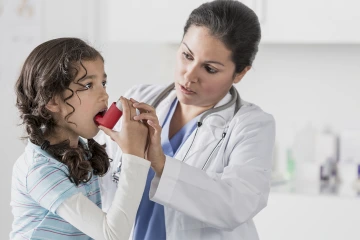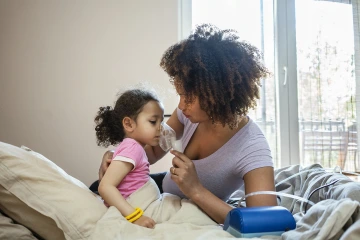Pediatric Pulmonary Center Succeeds with Comprehensive Care
Health professionals trained to work together can give children with severe pulmonary diseases better, more holistic care.

The Pediatric Pulmonary Center at Steele Children’s Research Center treats children with complex pulmonary diagnoses.
In today’s increasingly complicated health care setting, comprehensive care models often provide patients with a more convenient pathway for treatment and recovery. For children with complex pulmonary diseases, a comprehensive approach to providing care can make a critical difference in how well they can thrive in spite of their disease.

Cori Daines, MD
There aren’t enough multi-disciplinary pediatric pulmonary specialists in the country to provide adequate care for children with complex diseases. To help alleviate that shortage, a federal program has continuously funded the Pediatric Pulmonary Center (PPC) for two decades to train care providers to address complex diseases using a comprehensive approach. The PPC is part of the Steele Children’s Research Center in the College of Medicine – Tucson.
The driving philosophy behind the PPC is to create comprehensive interprofessional care models to give children a chance to live their lives without being defined by their disease, said Cori Daines, MD, PPC director. This vision embodies one of the University of Arizona Health Sciences’ priorities for changing the future of health care.
Bringing nurses, doctors, nutritionists, pharmacists, social workers and other health care professionals together to care for a family’s pediatric pulmonary needs is a way to address complex health care with appropriately dynamic solutions, Dr. Daines said.
“We try to understand that medicine is only part of what we do, and we try to make sure that medical care fits into the life of a child and of a family,” she said. “Medical care isn't the reason they exist, we're supporting them through that care so they can live their lives.”
Comprehensive care in action
Asthma and cystic fibrosis (CF) are examples of the pulmonary diseases the center sees. CF affects the lungs and digestive system and can cause difficulty breathing and lung infections.

Amanda Sharpe with her family. Sharpe is the Family Leadership Faculty for the Pediatric Pulmonary Center.
The PPC employs Amanda Sharpe as a patient advocate on the team in the role of Family Leadership Faculty. It’s her job to provide the patient voice, and she does so by drawing from her experience witnessing the daily care her husband undergoes to live with CF. Just being in the room when patients meet with the care team helps her reinforce the interprofessional collaboration.
For example, if a patient is told they are underweight, but they are dependent on getting nutrition from a gastrostomy tube overnight, they may wake up without an appetite. Sharpe said it’s not enough for a doctor to say, “gain weight,” and a nutritionist to say, “here are the appropriate snacks to help,” without realizing that the tube-fed patient isn’t able to eat more calories. She can provide support if a patient is overwhelmed or offer the patient perspective when the care team meets to determine a course of treatment.
“I think a lot of what our team does is trying to fit disease management into a patient’s daily schedule,” she said. Between medication regimens, daily treatments, standing appointments and all the trappings of daily life, it’s one thing to prescribe a course of action for treatment, and another to work with a patient to resolve what that actually looks like. With a team, that’s possible, Sharpe said.
When Dr. Daines walks into a room to see a patient, she always asks what they and their family want from the visit, and then calls upon the whole care team to address the family’s needs. The PPC typically trains at least one person in each health care profession each year to work with pediatric pulmonary patients.
Boosting the level of care
The center has been continuously funded by a grant from the Maternal and Child Health Bureau of the Health Resources and Services Administration for 20 years. This year, it received another 5-year operating grant to support its core focus: bolstering an interprofessional workforce training program for all caregivers who actively manage health for children with pulmonary diagnoses.

Pediatric pulmonary care can include breathing treatments, medications, behavioral therapies and more.
The center trains students who are working on their graduate or PhD degrees in various health disciplines. Their work in the PPC is a key clinical component of their education.
“I think we've developed several interprofessional programs that wouldn't have existed otherwise,” Dr. Daines said.
She said measurements of progress include, “Are we getting kids out of the hospital faster? Are we keeping them at home versus having them get readmitted? What is the quality of life like for our families that are living with these diseases?”
Trainees become leaders
While the program can improve one child’s life, the bigger impact comes from implementing a successful interprofessional model elsewhere, including Nevada, California, Hawaii and Title V health care agencies in Arizona that receive federal health care funding for mothers and children, especially children who have special needs.

Pediatric pulmonary patients and their families need specialized care from a team of health care professionals.
“You're just getting a better picture of that patient if you can put all the pieces together,” Sharpe said.
The federal grant requires the center to follow the health care trainees for up to 10 years to track their progress and to ensure they continue to teach others the benefits of an interprofessional care model. Dr. Daines said all of them have done so, some by returning to academic medicine to teach, others by working in community health organizations such as El Rio Health and training their peers.
“We are trying to put forward leaders, not just people who are interested in doing this in practice but who are going to go out into the community and model this level of care, training the new health professionals and really perpetuating this model.”

